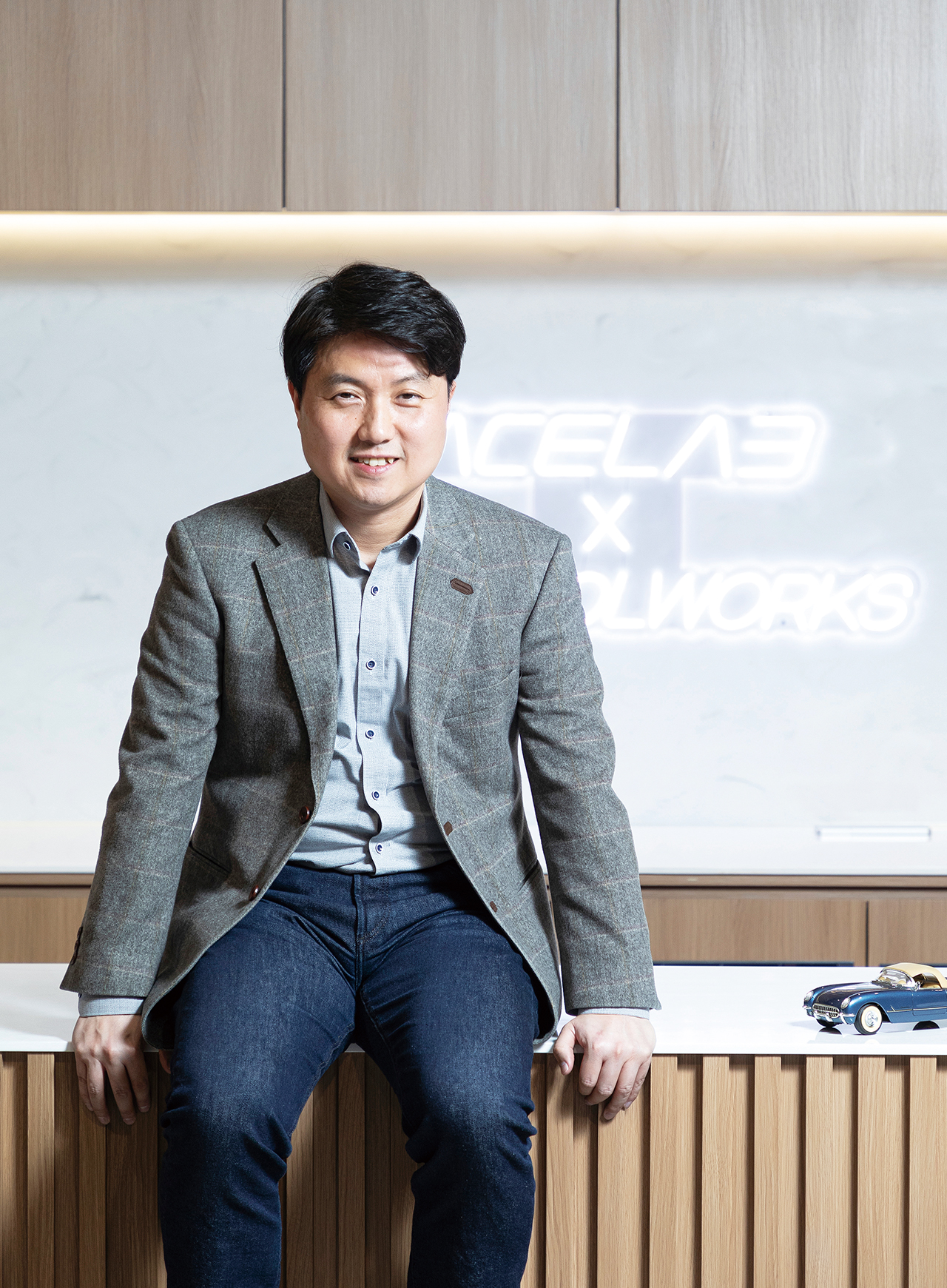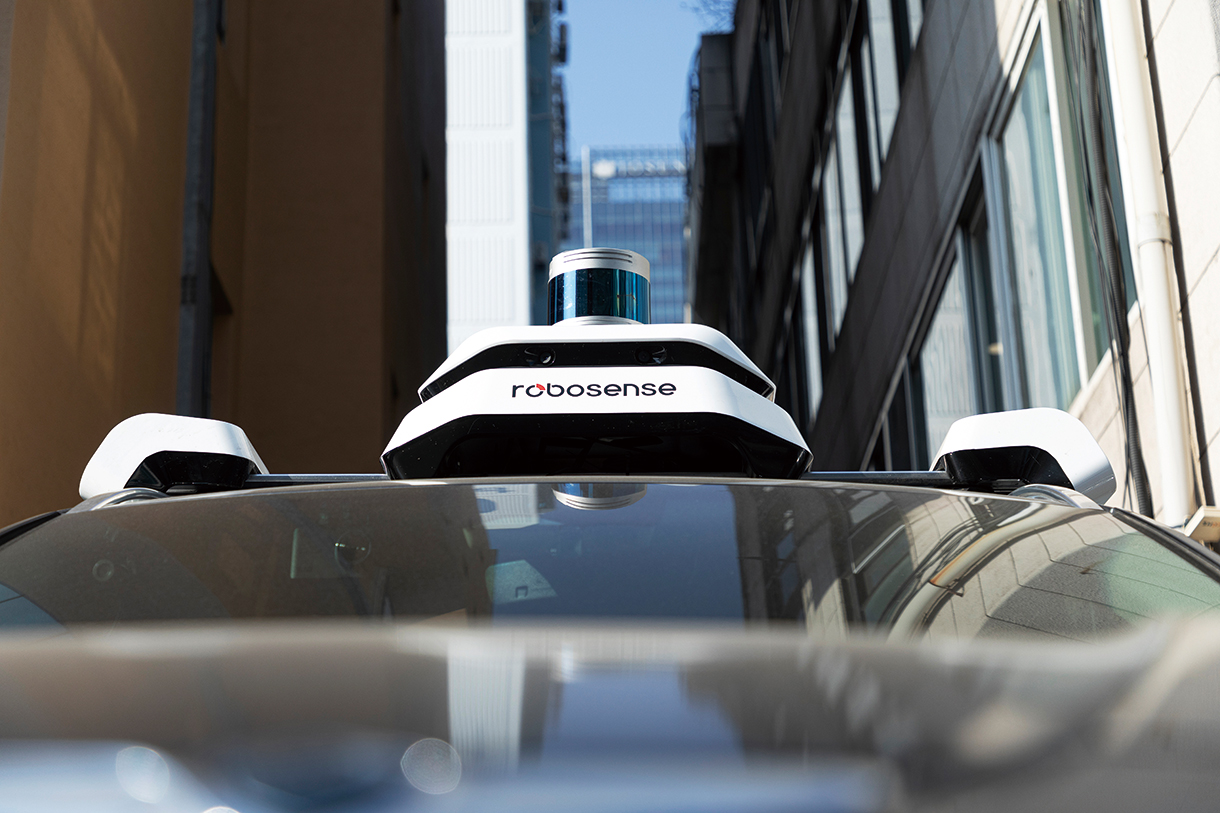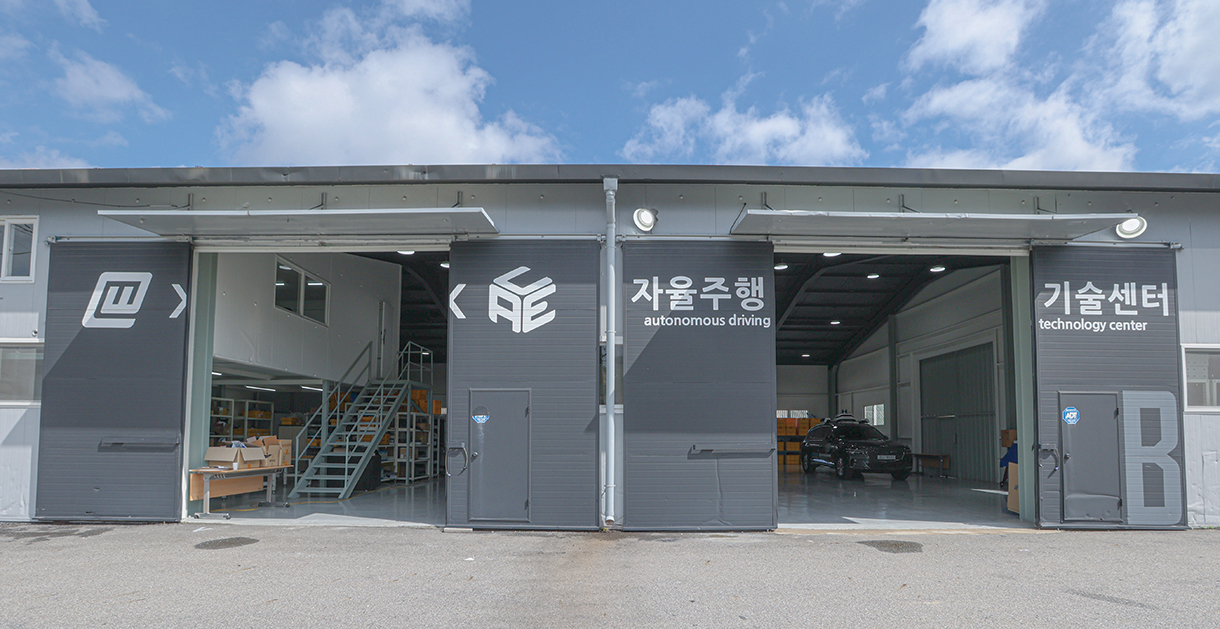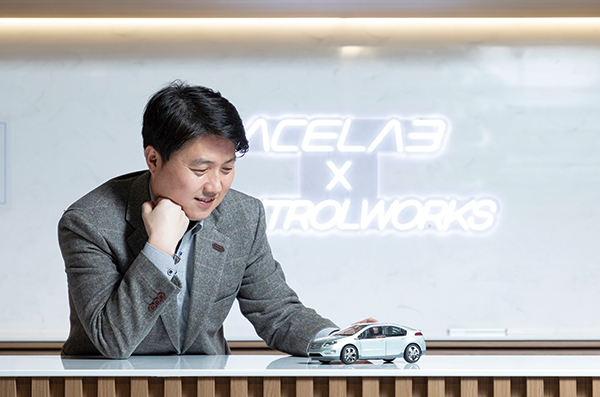

Story
자율주행 기술은
로봇 상용화 핵심 포인트
Autonomous Driving Technology
The Key to Commercialization of Robots
컨트롤웍스 박승범 대표
Seungbum Park, CEO of CONTROLWORKS
- 글 박영임
- 사진 이현구
- Writing Park Yeong-im
- Photograph Lee Hyeon-gu
Scroll Down
Seungbum Park is the CEO of CONTROLWORKS, a future mobility tech company that supports modeling, simulation, and validation of software for electric/autonomous driving vehicles. He is a regular guest speaker at various academic events and forums, delivering speeches on the current status of autonomous driving technologies and future prospects as a field expert. We interviewed him about the future of autonomous driving technology and robots.

자율주행 기술 어디까지 왔나?
집 안 구석구석을 다니며 청소해주는 신통한 로봇 청소기부터 공항이나 쇼핑몰에서 길을 안내해주는 가이드 로봇, 식당에서 음식을 날라다 주는 서빙 로봇, 주문한 상품을 배달해주는 배송 로봇에 이르기까지. 이들 로봇의 공통점은 알아서 최적의 경로를 탐색하고 장애물을 피하며 목적지를 찾아간다는 점이다. 그래서 이들을 ‘자율주행 로봇’이라고 한다. 자율주행이라 하면 자동차만을 연상하기 쉽지만, 자율주행 기술은 당연히 로봇 분야에도 적용된다. 컨트롤웍스 박승범 대표는 미래로 갈수록 로봇과 자동차의 경계 자체가 모호해질 것이라고 말한다.
“로봇이 모빌리티가 되면 로봇이 자동차가 되는 것이죠. 인기 영화 시리즈 ‘트랜스포머’처럼 필요에 따라 자동차와 사람의 모습으로 변신할 수 있는 그런 제품들이 시장을 지배하는 시대가 올 것입니다. 이것이 진정으로 시장이 원하는 것이죠. 재미있는 것은 트랜스포머에 나오는 로봇 이름이 ‘오토봇(Autobot)’이라는 겁니다. 어찌 보면 자동차와 로봇의 만남을 예견한 것인지도 모르겠습니다.”
사람이 직접 조작하지 않아도 외부 환경과 물체를 인지하고, 인지한 정보를 바탕으로 판단한 후 기계를 제어해 스스로 목적지까지 주행할 수 있게 하는 자율주행 기술은 미래 모빌리티 및 로봇의 핵심 기술이라 할 수 있다. 그동안은 미국자동차공학회(SAE)의 분류 기준에 따라 6단계로 자율주행 기술 단계를 부여했는데, 지난 1월 산업통상자원부 국가기술표준원에서 자율주행 기술에 대한 국가표준을 고시했다. 새 국가표준도 기술 분류를 6단계로 적용하고 있다. 이 중 운전자동화 기능이 없는 레벨0은 물론, 레벨1(운전자 보조), 레벨2(부분 운전자동화)는 무조건 운전자의 개입이 필요하다. 레벨3(조건부 운전자동화), 레벨4(고도 운전자동화)는 시스템이 조작하지만 상황에 따라 시스템이 운전자의 개입을 요청하기도 한다. 우리가 생각하는 완전한 자율주행은 레벨5(완전 운전자동화)로 도로 조건과 환경에 관계없이 전적으로 시스템이 주행하는 방식이다. 현재 우리나라에서는 2019년 12월 세계 최초로 레벨3 안전기준을 제정한 바 있으며, 현대자동차그룹이 지난 2021년 세종시와 남양연구소에서 레벨4 자율주행 시범서비스를 시작해 2022년에는 강남과 판교 지역으로 시범서비스를 확장했다.
“자율주행 기술은 아직 철학에 가깝습니다. 먼저 자율주행 기술을 수용할 수 있는 인식의 전환이 요구됩니다. 로봇이 운전해도 안전하고, 그래서 더 편리하다는 공감대가 형성돼야 비로소 어떤 기술을 사용할 것인지, 어떻게 구현할 것인지 정할 수 있죠. 현재는 필요성을 각인시키는 데 성공한 정도인 것 같습니다.”
How far has autonomous driving technology progressed?
One commonality of the robots- magical robot vacuum cleaners which clean every corner of the house, guide robots at airports or shopping malls, server robots that serve food in restaurants, and delivery robots that deliver products to customers' doorsteps-is that they all can search the optimal route independently and find their way to the final destination while avoiding obstacles. This is why they are referred to as “self-driving robots.” Although it is easy to associate autonomous driving only with cars, self-driving technologies also apply to robotics. According to Seungbum Park, the CEO of CONTROLWORKS, the boundary between robots and vehicles will only become more and more blurred as we head toward the autonomous technology future.
“If the future paradigm of mobility shifts toward robots, this means robots will be cars. Soon, there will be a time when products that can transform into vehicles or human beings at their own discretion just like we saw in the famous movie series, Transformers, dominate the world. This is what the market truly wants. What’s interesting here is that the name of the robot in Transformers is “Autobot.” This, in some way, suggests that the movie has foreseen the future of cars and robots.
One can say that autonomous driving, a technology that helps the vehicle reach its destination autonomously by recognizing the external environment and objects is the key technology of future mobility and robotics. While the six levels of autonomy defined by the Society of Automotive Engineers (SAE) have been used so far, in January this year, the Korean Agency for Technology and Standards (KATS), affiliated with the Ministry of Trade, Industry and Energy (MOTIE), established and announced standards for autonomous driving technology, which also consist of six levels. Among the six levels of driving automation, Level 0 (no driving automation), Level 1 (driver assistance, and Level 2 (partial driving automation) all require human drivers’ intervention. Although the system takes control from Level 3 (Conditional automation) and Level 4 (High automation), it sometimes requests the driver’s help in some situations. Vehicles at Level 5 (full automation) are fully autonomous, meaning that they can operate autonomously in all locations and under all conditions. The Korean government has announced the world’s first safety standards for Level 3 autonomous vehicles back in December 2019, and Hyundai Motor Group has expanded its pilot Level 4 autonomous driving service to Gangnam and Pangyo in 2022 after first launching it in Sejong City and the Namyang R&D Center in 2021.
“Self-driving technologies are still more of a philosophy than reality. This means that for the technology to become part of our daily lives, there needs to be a change in the way we perceive and view it. Only after consensus is reached that vehicles driven by robots are safe, and thus more convenient, can we decide which technology to use and establish an implementation plan. At the current stage, we’ve only succeeded in having people recognize the importance of autonomous driving vehicles.”

살아있는 소프트웨어 구현이 핵심
자율주행 시스템에는 정밀 센서, 딥러닝을 포함한 응용 소프트웨어, 안전과 보안을 보장하는 시스템 소프트웨어 등 최첨단 소프트웨어와 하드웨어가 집약된다. 박승범 대표는 자율주행에 적용되는 기술을 ‘인지-판단-제어’의 과정으로 설명했다. 먼저 도로교통 상황과 인근 차량이나 사람, 시설 등 외부 환경을 정확하게 인지해야 하는데 여기에는 레이다, 카메라, 라이다, 적외선 센서 같은 다양한 센서 기술과 통신 네트워크가 필요하다. 두 번째, 판단 과정에서는 인지한 데이터를 종합해 신뢰할만한 판단을 빠르게 도출해야 한다. 이를 위해 인공지능을 활용한 전용 칩을 개발해야 한다. 한마디로 움직이는 컴퓨터라 할 수 있다. 마지막 제어 과정은 판단한 근거에 따라 실제 주행하는 단계로 시스템 통합 기술이 요구된다.
“사실 자율주행과 관계없는 기술은 거의 없다고 보면 됩니다. 다만, 관계가 더 깊고 중요하며, 성패를 좌우할 기술과 그렇지 못한 기술로 자연스럽게 구분되는 것이죠. 제 생각에 자율주행 현실화에 가장 중요한 기술은 소프트웨어와 데이터입니다. 데이터 수집을 통해 소프트웨어를 지속적으로 업데이트해 기능을 개선하고 추가할 수 있는 살아있는 소프트웨어를 구현해야 합니다.”
로봇의 자율주행 기술 원리도 자율주행 자동차와 크게 다르지 않다. 하지만 차도만 달리는 자동차와 달리 로봇은 인도나 건물 안을 주행하기 때문에 턱이나 홈, 계단, 경사 등 보다 다양한 장애물과 보행자의 돌출행동에 대처해야 한다. 반면 로봇에는 인간이 탑승하지 않으며 자동차 주행 속도보다 느리므로 자율주행 자동차에서 우려되는 대형 사고의 위험성은 덜 수 있다. 박승범 대표는 자율주행 로봇이 자율주행 문화를 보급하는 일등공신이 될 수 있다고 지적했다.
“서빙 로봇은 이미 효용성이 입증됐습니다. 배송 로봇도 딜리버리 시장이 확장되면서 수요가 높아지고 있죠. 자율주행 로봇이 곳곳에 활용되면서 사회 전반적으로 자율주행에 대한 수용성이 향상되고 있습니다.”
What is the importance of realization of living software?
The autonomous driving system is composed of cutting-edge software and hardware, including sensors, application software such as deep learning, and system software that guarantees safety and security. The CEO of CONTROLWORKS used the process of “perception-planning-control” to explain the technologies applied to autonomous driving. First of all, a variety of sensor technologies, including radar, camera, LiDAR, and infrared sensor, and a telecommunication network are required to accurately perceive the surroundings such as traffic conditions, nearby cars, pedestrians, and other obstacles. The second part of the process, planning, is about using the data perceived to quickly reach a reliable decision. This is why AI chips specifically designed for autonomous vehicles, or computers that can move, should be developed. Control, the last step of the process, is when the vehicle actually moves based on the planned actions generated by the higher level processes, and requires system integration technologies.
“In fact, it’s extremely difficult to find technology that has nothing to do with autonomous driving. It’s just that there are some technologies that determine success and are more relevant than others. From my perspective, software and data are the most essential technologies that can help driverless vehicles become a reality on our roads. Developing so-called living software that improves and adds features through regular updates and data collection is a key success factor in realizing that future.”
In fact, the way autonomous robot technologies work isn’t that much different from that of autonomous vehicles. However, since robots have to move along the sidewalk or inside buildings unlike vehicles, they have to be prepared for various obstacles, including staircases, cracks on the floor, slopes, and for pedestrians’ unexpected behavior. On the other hand, robots, with no human drivers and a relatively slow speed compared to selfdriving cars, are less exposed to serious accidents. Mr. Park pointed out that autonomous robots have the possibility to spread the culture of autonomous driving.
“Serving robots are already proven to be useful and beneficial. Along with the growth of the delivery market, the demand for delivery robots is rising. Receptivity toward autonomous driving is improving across the overall society as autonomous robots are now utilized for various purposes.”


사람의 직접적인 조작 없이 인지-판단-제어하는 자율주행 기술은 미래 모빌리티 및 로봇 발전의 핵심 기술이다
Autonomous driving technologies capable of perceptionplanning-control, without human intervention, are core technologies that will determine the success of future mobility and robotics.
자율주행 로봇의 진화 기대
사실 로봇과 자동차의 결합은 SF 영화에서나 가능한 일이었기에 지금까지 로봇과 자동차 산업은 별개의 영역이었다. 하지만 현대자동차그룹이 미국의 유명 로봇 제조사 보스턴 다이내믹스를 인수하고 로봇 사업에 본격적으로 진출했듯이 둘 사이의 관계는 매우 긴밀하다.
“자동차 부문에서 잘하는 기업이 로봇 부문에서도 잘한다거나, 로봇 부문에서 잘하는 기업이 자동차 부문에서도 잘한다는 연관성은 없습니다. 그런데 이 거리감을 획기적으로 줄여줄 수 있는 것이 바로 자율주행 기술입니다. 완벽한 자율주행이 구현되면 점점 자동차의 덩치가 작아지고, 어떤 면에서는 로봇의 형태로 발전할 수도 있겠죠. 자율주행 로봇의 경우도 사전에 정해진 일만 반복적으로 수행하던 것에서 벗어나 사람의 골칫거리를 알아서 해결하는 로봇으로 진화할 것입니다.”
박승범 대표는 빠르게 발전하는 인공지능의 속도에 비춰 2027~2030년이면 완전 자율주행 기술이 실현되리라 전망했다. 박승범 대표가 이끄는 컨트롤웍스는 이런 전망에 따라 목표를 정하고 미래를 개척해가고 있다. 2025년 국내 1등 모빌리티 테크기업으로 자리매김하고, 2030년에는 모빌리티 기술의 변화를 주도하는 글로벌 모범 사례로 자리 잡을 것이다. 박승범 대표는 한양인들에게도 한국의 미래 모빌리티 산업, 자율주행 로봇 분야 경쟁력 강화에 힘을 보탤 것을 당부했다.
“한양대의 실용학풍을 잘 융합해 ‘자율주행 시뮬레이션은 한양대가 제일 잘하더라’, ‘한양대 모빌리티용 보안기술은 CIA도 못 뚫는다더라’ 등 특화 실용 기술을 보유하기를, 그 국내 기술이 글로벌 시장 우위를 선점하는 데 앞장서기를 바랍니다.”
What are the future prospects for self-driving robots?
Actually, since the combination of robots and vehicles was something that was only possible in science fiction movies, there was always a distinct division between the two industries. However, the boundaries have become blurred, as shown in the example of Hyundai Motor Group, which entered into the robotics industry in full scale after officially acquiring Boston Dynamics, a well-known American robot manufacturing company.
“Companies that show good performance in the automotive industry are not necessarily good in the robotics industry and vice versa. While these two industries may seem distinct, autonomous technology is what can reduce the gap significantly. When autonomous driving is perfected, the size of the vehicles will become smaller, and in a way, they will evolve to be like robots. Self-driving robots will also evolve to resolve people’s pain points on their own, overcoming their previous limitation of only executing actions repeatedly based on what’s been determined and set in advance.”
Mr. Park shared his outlook on autonomous-driving technology, saying that it will become part of our lives by 2027-2030, considering how fast AI is developing. CONTROLWORKS continues to pioneer the future based on the same perspectives. The company aims to become the top mobility tech business by 2025 and an international best practice that spearheads advancements in mobility technology in 2030. The CEO of CONTROLWORKS asked students at Hanyang to contribute to improving the competitiveness of Korea’s future mobility industry and self-driving robotics.
“I hope you use what you’ve learned from Hanyang University’s pragmatic learning values and secure practical technologies, proving to everyone that Hanyang is the best when it comes to autonomous driving simulation tests, and that Hanyang’s security technologies for mobility are so advanced that not even the CIA can crack them. And I hope that you can take the lead in ensuring that the technology has the upper hand in the global market.”
컨트롤웍스 박승범 대표는?
2002년 한양대에서 자동차공학 박사를 취득한 후 산업계에서 20여 년간 활약 중이다. 현대기아연구개발본부에서 독자 제어기를 개발하고, 자율주행 양산기업 HL클레무브(구 만도)에서 첨단 레이더 센서와 핵심 소프트웨어의 100% 국산화에 일조했다. 주요 자율주행대회를 석권한 한양대 ACE Lab 자율주행 자동차 A1 개발의 기술 자문을 수행했으며 현재 한국자율주행산업협회 이사, 자율주행기술개발혁신사업단 위원을 맡고 있다. 2020년부터 미래 모빌리티 테크기업 ㈜컨트롤웍스의 대표이사를 맡고 있다.
Who is Seungbum Park, the CEO of CONTROLWORKS?
Seungbum Park has been in the industry for more than 20 years after obtaining a doctorate degree in Automotive Engineering in 2002. He has developed an independent controller at Hyundai Kia Motors R&D Division, and has contributed to 100% localization of cutting-edge radar sensors and core software while working at HL Klemove (spinoff from Mando), a company that mass-produces autonomous driving products. He was also the technical advisor for the autonomous car, dubbed A1, developed by Hanyang University’s ACE Lab, a lab that swept all the awards at major autonomous driving contests, and is now the Director of the Korea Association of Autonomous Mobility Industry (KAAMI), and member of the Korea Autonomous Driving Development Innovation Foundation (KADIF). He has been CEO of CONTROLWORKS, a future mobility tech company, after being appointed in 2020.
